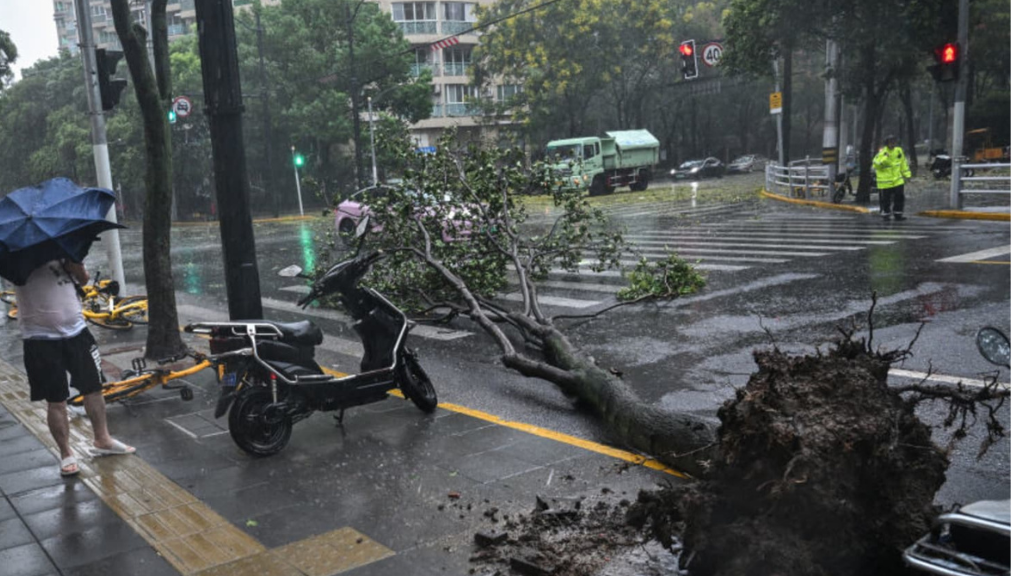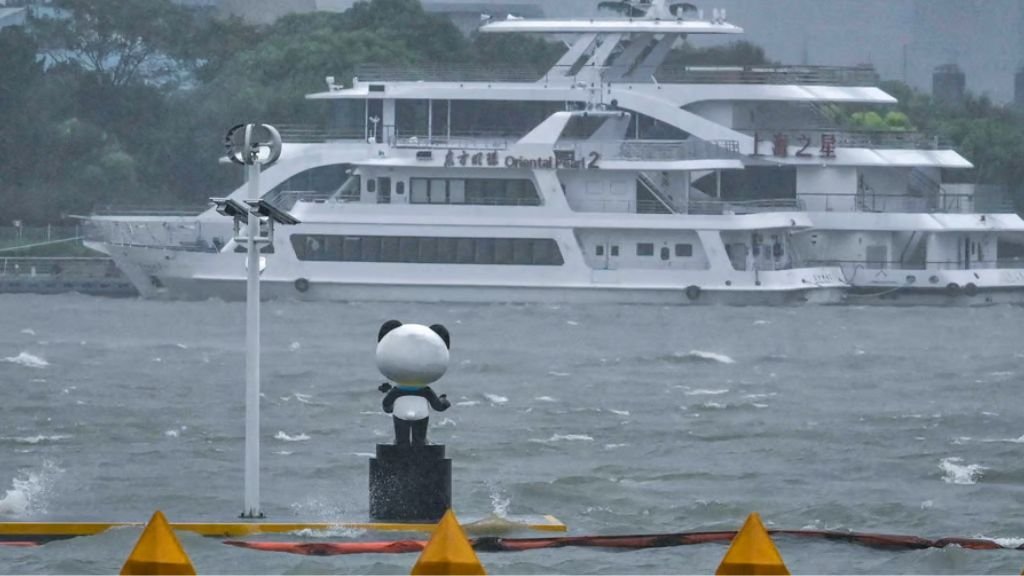Shanghai was hit by Typhoon Bebinca on Monday, September 15, marking the strongest storm the city has experienced in 75 years. The typhoon, with wind speeds reaching up to 151 kph (94 mph), made landfall at around 7:30 a.m. local time (11:30 p.m. GMT Sunday) near the coastal area of Lingang New City in Shanghai’s east. The storm brought chaos to the city, toppling trees, flooding streets, and forcing hundreds of thousands of residents to evacuate.
Shanghai, a city of 25 million people, faced severe weather conditions throughout the day as strong winds and heavy rain battered the area. State media reported widespread disruption, including the cancellation of hundreds of flights and the suspension of rail services. Footage aired by Chinese broadcaster CCTV showed trees uprooted, billboards collapsing, and clean-up crews already at work as the typhoon began to subside.
Since Sunday evening, authorities had already relocated more than 400,000 residents in preparation for the storm. The evacuations included 9,000 people from the Chongming District, an island located at the mouth of the Yangtze River and part of the Shanghai Metropolitan Area. Authorities warned residents to stay indoors and avoid unnecessary travel as the storm worsened, with wind speeds at the typhoon’s center reaching dangerous levels.

By Monday morning, Shanghai was put under a red alert, the highest warning level for typhoons in China. This alert came as Bebinca approached, bringing with it intense winds and heavy rain. The China Meteorological Administration warned that the storm would continue to affect nearby provinces, including Jiangsu, Zhejiang, and Anhui, as it moved inland. Although the storm was expected to weaken, authorities remained on high alert, closely monitoring the situation.
The impact of Typhoon Bebinca was not just limited to Shanghai. In Suzhou, a city located west of Shanghai, dozens of workers and residents were moved to temporary shelters. Schools and businesses remained closed, and many ferries, including those leading to Shanghai’s outlying islands, were halted. Videos shared on social media, particularly on the Chinese platform Weibo, showed the extent of the damage. Large trees had been uprooted, and streets were flooded, with residents struggling to navigate through the water. One video even captured a bus along Huaihai Road, a popular shopping district, stopping abruptly as billboards collapsed in the high winds.
The typhoon’s devastation extended beyond the physical damage, as residents expressed their fear and frustration online. Many took to social media to share their experiences, with some posting videos of trees swaying dangerously and streets submerged under water. One resident described the scene as something you “would only see on television,” while another urged fellow citizens to secure their homes and avoid venturing outside.
Despite the chaos, there have been no immediate reports of casualties in Shanghai, though the authorities are still assessing the full extent of the damage. The city’s flood control headquarters received dozens of reports related to fallen trees and damaged infrastructure, but there have been no major incidents so far.
Elsewhere in China, Typhoon Bebinca had already made its presence felt before arriving in Shanghai. The storm passed through Japan and the Philippines earlier in the week, causing widespread damage. In the Philippines, six people were killed by falling trees, while in Japan, several cities experienced power outages and transportation disruptions. The storm’s path also led to heavy rainfall and flooding in other parts of Southeast Asia, with fears that Bebinca could worsen the region’s already vulnerable situation after previous typhoons.
As a result of the typhoon, popular tourist destinations in Shanghai have temporarily closed their doors. Shanghai Disney Resort, Jinjiang Amusement Park, and Shanghai Wild Animal Park were all forced to shut down as a precautionary measure. Authorities are expected to review the situation and determine when these attractions can safely reopen.
Shanghai’s unique location typically protects it from direct hits by typhoons, as these storms usually make landfall further south along China’s coastline. However, Typhoon Bebinca broke this pattern, becoming the strongest storm to strike Shanghai since Typhoon Gloria in 1949. The intensity of Bebinca has raised concerns about the increasing frequency and strength of typhoons in the region, as climate change continues to alter weather patterns.
In addition to the immediate evacuation and safety efforts, authorities are preparing for a prolonged period of recovery. Clean-up crews have already begun work in the affected areas, and power has been restored in some parts of the city. However, with widespread infrastructure damage, it is expected that full recovery will take time.
Residents have been advised to remain cautious even after the typhoon weakens, as flooding and falling debris continue to pose risks. The Shanghai government has promised to provide assistance to those affected, ensuring that the city’s recovery efforts will be swift and coordinated. Authorities are also working to restore transportation services, including flights and trains, which were heavily disrupted by the storm.
Typhoon Bebinca will be remembered as one of the most powerful storms in Shanghai’s history, causing widespread disruption and reminding residents of the city’s vulnerability to extreme weather events. As the storm moves inland, the focus will shift to recovery and rebuilding, with hopes that the city can return to normalcy soon. However, with climate change becoming an ever-present concern, residents and authorities alike are preparing for the possibility of more frequent and intense storms in the future.


